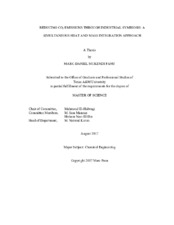| dc.description.abstract | CO₂ emissions have a harmful effect on the environment as CO₂ is the most significant contributor to global climate change. In 2015, representatives from countries around the globe met at the Paris Climate Conference to discuss the status of the global carbon budget and climate change. There, it was agreed to make a global effort to reduce greenhouse gas emissions. It is expected intergovernmental mandates will be implemented to limit CO₂ emissions in effort to cap the global temperature rise at 2°C above pre-industrial temperatures.
Reduction of CO₂ emissions is one of the most important strategies in addressing global climate change. About half of all CO₂ emissions come from industry and power plants. Therefore, these stationary sources are logical starting points for consideration. A commonly proposed solution to reducing CO₂ emissions is Carbon Capture, Utilization and Sequestration (CCUS). This strategy presents the opportunity to simultaneously reduce CO₂ emissions and create valuable products from waste material, generating profit for companies without the need to overhaul the energy infrastructure. However, despite the promise of CCUS, the chemical properties of CO₂ have rendered many developments in this area to be cost prohibitive.
The objective of this work is to demonstrate that by applying the principles of heat and mass integration through an industrial-symbiosis approach, CO₂ utilization processes can be integrated into eco-industrial parks to yield value-added chemicals in a cost-effective manner while offering enhanced CO₂ fixation. A hierarchical approach and an optimization formulation have been developed to screen the alternatives and to provide conceptual designs of the promising pathways and integration strategies.
A case study was solved to illustrate the merits of the proposed approach. Preliminary screening shows that, when integrated with a typical hydrocarbon processing industrial city, urea, methanol, formic acid, acetic acid and ethylene glycol are viable candidates for production from CO₂. Various configurations of these processes show a positive net fixation of CO₂ while generating a profit. The overall reduction of CO₂ emissions, however, is limited to around 16% due to capacity constraints on the new processes. | en |


